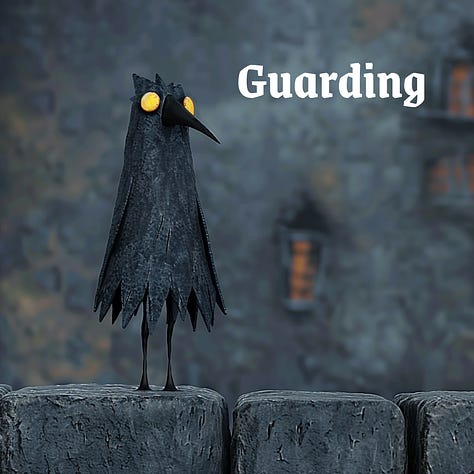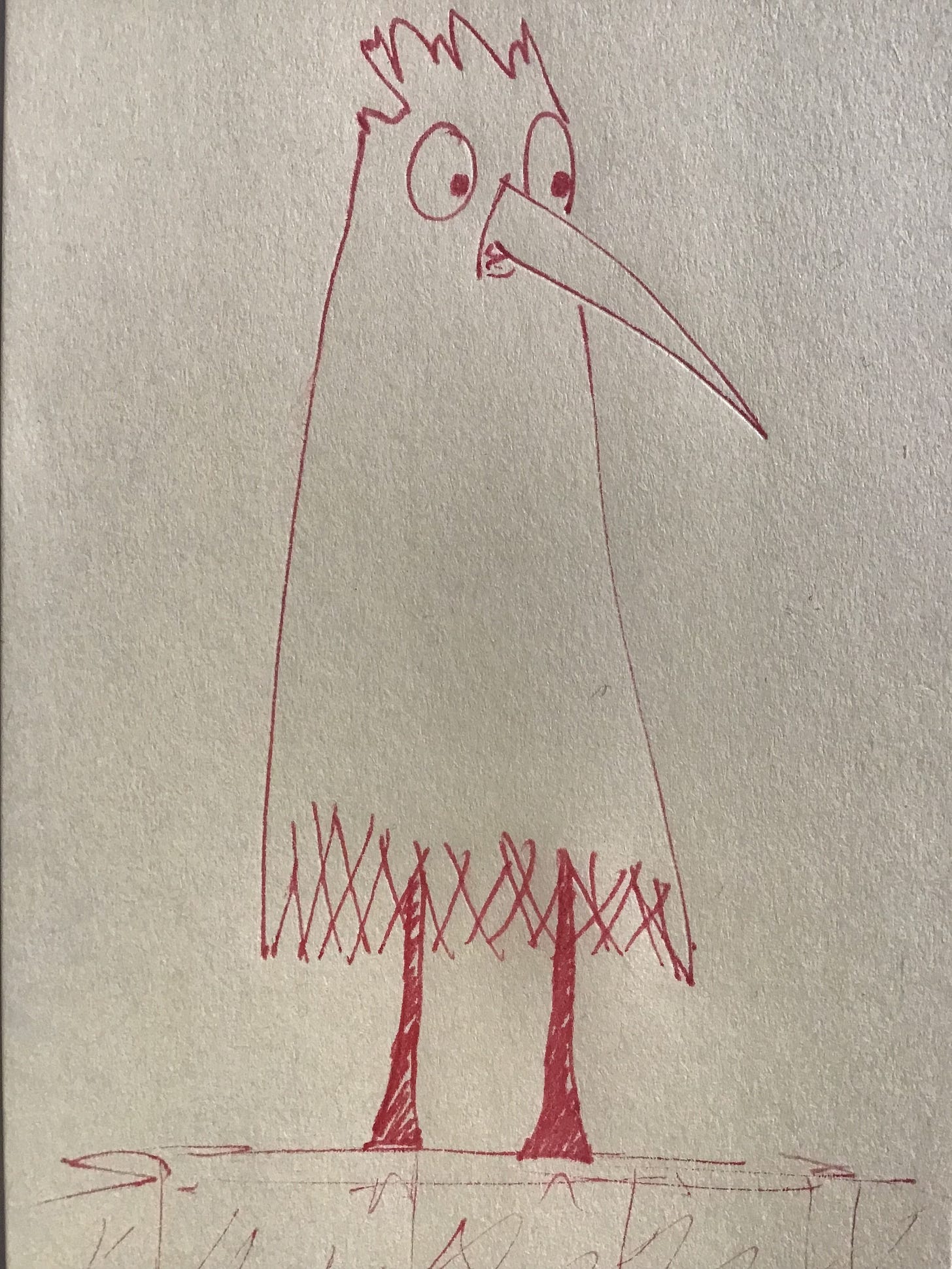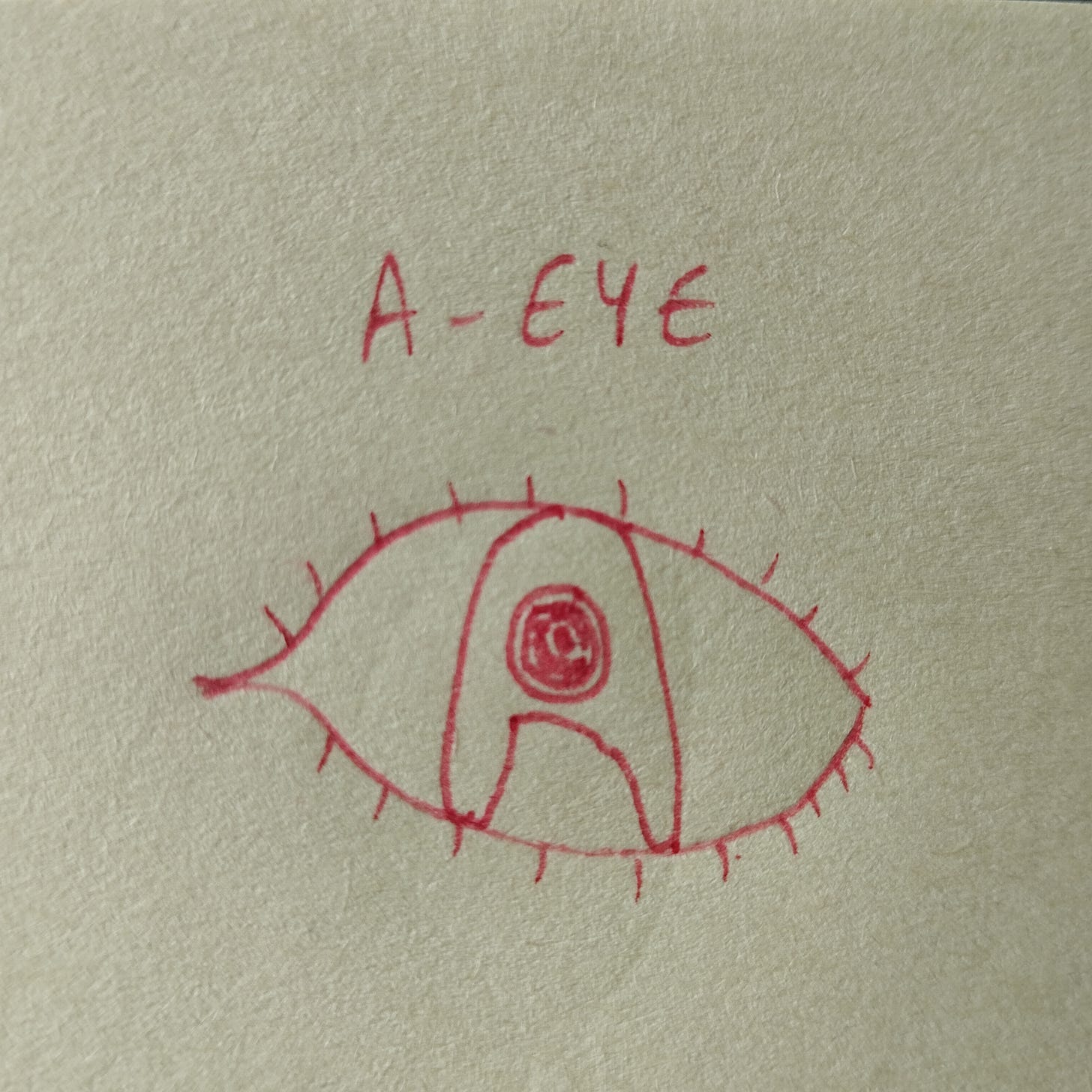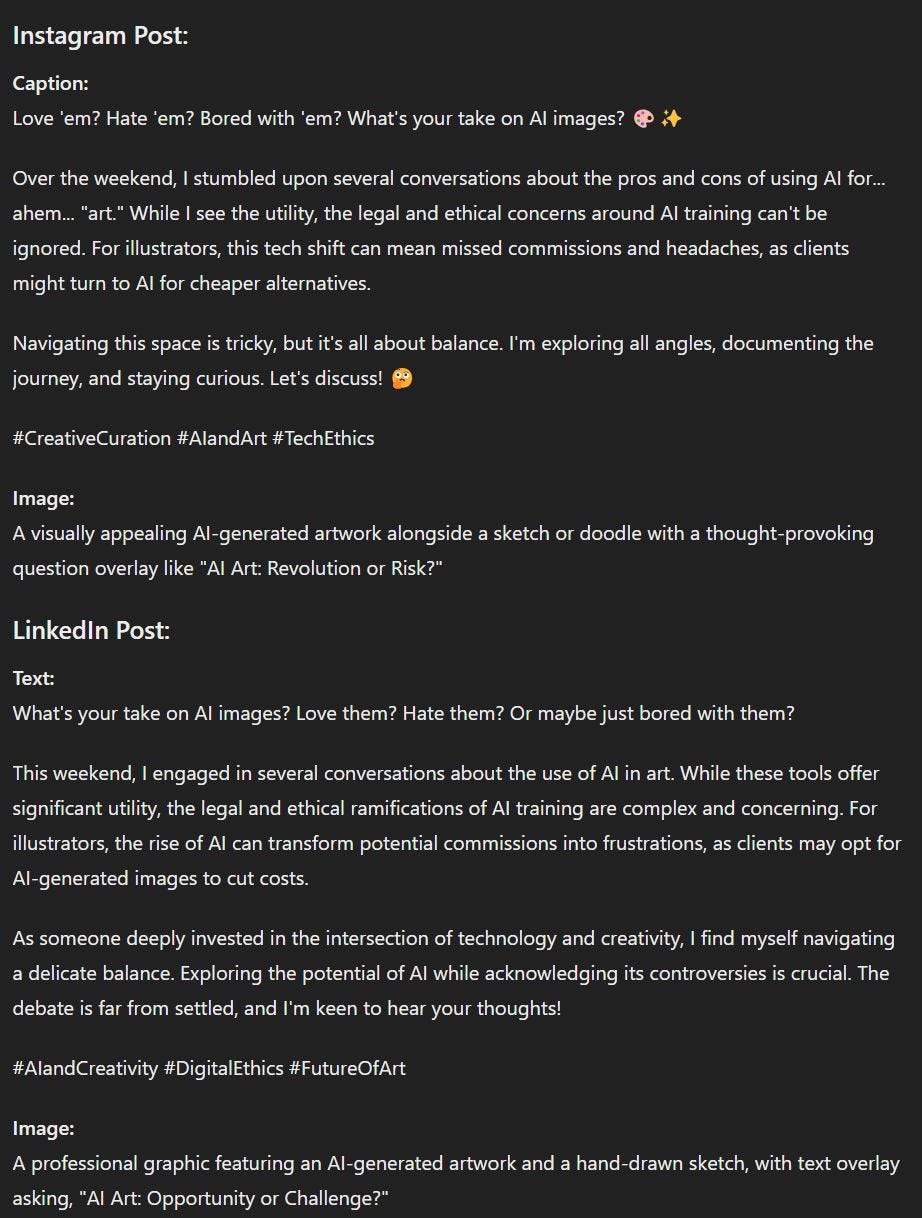Images. What's Real, What's Fake, What's Okay?
And where do we draw the line? Or can AI draw that for us too?
Love 'em? Hate 'em? Bored with 'em?
What's your take on AI images?
And with that question, please don’t run away just yet. Pretty please.
Over the weekend, I stumbled upon several conversations about the pros and cons of using AI for... ahem... art.
I don't call the raw generations art, but I do see good uses for the images.
First off, however, I must acknowledge the big-picture situation before parking that to one side. It’s not the main drive of this piece, but we need to start there before veering off.
The Legal, Ethical, and Economic Considerations
We need to get these out of the way here because we can’t just get them out of the way.
I'm uncomfortable about the legal and ethical situation surrounding the way AI models have been trained. I see use in the tools, but I see valid and important arguments being made about the way any style and flavour of image can be created. I've explored how easy this is behind the scenes. If you know what you’re doing and what to use, pretty much anything is possible. And it’s getting easier. The high-end art scene and physical artworks won’t necessarily suffer much for it, but working artists—particularly digital artists—reliant on commissions, are already caught up in economic woes in attempting to make a sustainable living from art more difficult than they already are.
A commission request can turn into a headache for an illustrator if the offered terms are not favourable. A potential client might offer too little compensation. Rather than negotiating or finding another artist more suited to their budget, they might turn to an AI solution. In no time, they achieve a style similar to what they wanted, but at much lower cost, if not practically free.
This situation was thrown upon an unprepared public. And now we're left to mostly argue amongst ourselves. One day, not in the near future, some cases will be heard and some rulings made. Maybe some appeals. Maybe the tech having moved on in new ways that need yet more lengthy cases.
On that front, I'm stumped.
Don't do anything and I fall behind from my curious place. I'm interested, I'm looking to learn, and it makes sense to.
Yet do too much AI-centric stuff and I risk ignoring the controversy altogether for personal pleasure. Perhaps excessive personal gain.
All I can do is navigate with balance, and keep the bulk of my work and learning behind the scenes. I can explore all angles and document stuff, but without going all in. Unless...
Unless that's my main focus. At first, I thought it was. But my aim isn't to deliberately court controversy or suggest answers when they aren't available in anything other than dynamic extremes right now. Neither cry of "Let it in!" or "Keep it out!" seems valid through my own curious lens, though I don't take issue with those who currently have one of those cries in place.
As I said above, there are valid and important arguments.
It's why I'm impressed with how game-changing the AI explosion has been, yet I'm also more aligned with the skeptical Gary Marcus view until I see further progress in capabilities. Check out Gary’s excellent posts on Substack for all the deets. We've already got enough to chew over without the need to throw ourselves into a future that hasn't yet been proven.



A Curation of Creations
With those big-picture issues firmly mentioned, I'll stick to the art and creativity part of this AI discussion. If training data and the like weren't a consideration, where would algorithms take art, if anywhere at all?
To start, the image is not the art when I'm creating. For me, the curation is my offering. Any image outputs help me bring shape or flavour or extra context to what I'm doing. Those images don't need to be the centre of proceedings, or they can be the bulk of what I work around. Either way.
The aim isn't to produce visual art and impressive canvas works. I seek stories. I want wordplay. I look to build a narrative and maintain a suitable structure that pleases me and, hopefully, others. Something to enhance a message.
I call my AI image work, "creative curation". I don't create the work itself, much like a stock photo, but I've brought it into my creative fold.
I can use reference images of my own sketches and abstract doodles and forcing the algorithm to concentrate mainly on my own work. It pushes me out of my comfort zone of not having been one to draw much in the past (other than comics for friends many years ago!).
Even with reference images used and setting the AI to use them to greatest effect, I still wouldn't see the AI outputs as all my creation.
My struggle to see how to work in a safe space with all this has been at play for nearly two years now. As a lover and supporter of art, but not a graphic artist or illustrator myself, I find uses for the images to complement my other work. I like to give titles and have a consistent theme, and sometimes I'll produce full narratives and poems and other elements around the images. Even the collections are curated with purpose, making the curation more artistic/creative than the pictures in principle.



Is “Instead of AI” a Useful Approach?
When the main goal isn’t to curate collections or find creative ways to support another body of work, is there more value in finding alternatives to AI image generations in order to explicitly supporting artists?
Even Substack, where I write this newsletter, has an AI generation option when I select the option to add images. Type a prompt, get some generations, then add away.
Simple. Maybe too simple. Almost to the point of showing little creative return. And while this might be fine for the person publishing their piece, have they thought about the choices they’ve made. And do they even care?
I ask that not to go back to the big picture issues, but to explore the possibility that art and creativity may not even be big considerations for everyone. A writer may value their words, without realising that an artist values their illustrations. To be a creative is a broad range of things.
For creatives who want to collaborate with others and help fellow creatives under that broad umbrella, there are some cases where “instead of AI” can benefit.
Tasha Goddard suggested that writers can work with illustrators and use actual artworks to complement the work. That, in turn, would support those artists. It’s an excellent angle, and I'd love to work in this direction too. I’ll reach out to artists and see if any are interested. I’ve long been a fan of seeing magazine articles and newsletter pieces that use illustrations across one theme. They both shape and complement the written word in beautiful ways. It’s what I try to do in some of my articles with themed AI curations. The opportunity to do the same whilst supporting a working artist would be fab.
For all the AI imagery I’ve explored, alternatives to using AI-gens as a default are important.
Room For Everything… Is Balance Possible?
The difficulty in finding balance is something I've talked about before, and it formed my very first newsletter piece on Substack. Not much has changed with the AI situation over the months, even as I change. A lot has happened for me on a personal and professional front in a few short months. But the AI and art thing... Everything is similar. The tech marches on, relentless. The public continues to argue the toss. The company bosses and government leaders still say their thing about regulations and the future and all that jazz.
So I thought I'd bring this up again. After all, I commented on the subject of AI images in three different Substack conversations over the weekend. The universe is trying to tell me something. Or is it the algorithm? 🤔
Whatever the case, I'm subscribed to hundreds of newsletters. That's more than enough to see people who are leaning in to AI images as their norm, people who are rallying against AI images to the point of blocking anyone who dares to use them in a newsletter, and people who haven't even considered the matter much more than with a shrug.
And that's understandable.
For the foreseeable future, things will continue to stay this way. Balance is hard to achieve when we don’t have a standardised set of scales to work with.
I hope you like my doodle at the start of this essay. All for the 30 seconds it took. And I hope you can forgive the AI generations that followed after. I liked the theme, I liked putting words to them, and it made sense at the time. :)
Here, have another 30-second doodle.
Can AI and Writing Offer Any Clues (or Threats)?
AI images don’t replace art. AI images don’t replace 30-second doodles. I’m happy to go down that route alongside artworks and doodles and all sorts of visually creative endeavours.
AI writing isn’t a threat to me at the moment. Maybe one day it will be, and maybe it will never be. I’ve used these tools more than enough to know that the low-hanging fruit of lazy writing, clickbait stuff, and purely informational detail can be replicated a reliable amount.
Everything else has a long way to go. At best—or worst, depends on your view—a fully AI-generated text will need a lot of editing and polishing.
Can the same be said of AI images? Maybe not so much. For all the talk of these images lacking emotion and depth, plenty of viewers are happily moved. And some images will look real enough to appear real. I’m not referring to photos, I’m talking about paintings and digital illustrations.
Just because the majority of AI stuff looks just like AI stuff is irrelevant. It’s still early days of people prompting en masse.
And some generations that aren’t quite right can be amended by AI means until they do look fine. Or you can do a bit of tweaking in an image editor… How much tweaking is needed to make it your own creation? A little? A lot? No amount whatsoever?
If I use a reference image, have I started the process? Or is that the same as writing an article and then getting AI to help with editing. Have I turned my own writing into AI writing?
Well, I'm happy to use AI as a tool. You can probably tell that based on this piece. And I’ve also said that using my own reference images don’t turn AI outputs into my own artist talent. In the UK, I can currently claim copyright for the outputs, which is unlike many other countries, including the US.
That’s right, more complications because some things depend on where you live. And, of course, they can change.
This is why I agree with Christopher S. Penn when he recommends disclosing the use of AI.
So let’s go through what I’ve done for this article.
Did I get AI to write it? No.
But I did ask for a quick editorial check. Several minor suggestions were made, all about making the piece more formal. Nope! I’m happy with my voice, cheers.
But it did pick up on one paragraph in particular and said it was far too awkward. I agreed.
It's the one thing I've changed.
With full disclosure below, see what you think and let me know if the decisions (both AI and mine) were worthwhile.
—
My original first-draft paragraph:
"For illustrators, what could have been a commission can end up a headache if the terms aren't favourable enough to accept. Someone looking to commission the artist may offer too little, for instance. Instead of negotiating or seeking an alternative artist within price range, they may instead turn to AI methods. In no time, they get the style to match close enough to what they wanted anyway, for a fraction of the cost, if not for free."
AI suggestion:
"For illustrators, a potential commission can turn into a headache if the offered terms are not favourable. A client might propose too low a fee, and rather than negotiating or seeking another artist within their budget, they might opt for AI solutions. In no time, they achieve a style similar to what they wanted, but at a much lower cost, or even free of charge."
My final edit (as published above):
"A commission request can turn into a headache for an illustrator if the offered terms are not favourable. A potential client might offer too little compensation. Rather than negotiating or finding another artist more suited to their budget, they might turn to an AI solution. In no time, they achieve a style similar to what they wanted, but at much lower cost, if not practically free."
—
Even suggested edits need an overhaul to get it working to suit your voice/style/needs.
That said, I've got limited time. If I was able to write this piece myself, but use AI to draft social posts for me, how much is my voice and how much is automated content?
Here you go, see what you think!
If I intended to use them, I'd edit these Instagram and LinkedIn suggestions for sure.
But they'd just about work without changing if I was really pushed for time and desperate to post. Again, does that make it shameless AI, partly me, or close enough to let it pass almost verbatim as my own words?
Where do we draw the line?
As you can see, this has been a big deal since ChatGPT dropped little more than 18-months ago. A year and a half. That’s nothing!
The global conversation over AI has been plenty over that time, but I'm not sure we've got much further either. That's reassuring in some ways and worrying in others.
For now, I can’t see where to draw the line. Or how to draw it. But I know it won’t be sensible to let AI draw *that* line for us.
After all this, what's your perspective? AI images as part of the toolbox or a step too far removed? Is there acceptable context before lines are crossed? How much creative work does a writer or an artist need to do before using AI to make some sort of decision, change, or (dare I say it) creation? And will we ever get clarity on all this to allow a more settled and balanced approach for all? If you've got this far, I'd love to hear your take.




